Case study: Biased curriculum on Israel and Islam in a Massachusetts school system
A Review of “Indoctrinating Our Youth: How a U.S. Public School Curriculum Skews the Arab-Israeli Conflict and Islam”

Anti-Israel propaganda is common on America’s college and university campuses. But as we’ve highlighted in a number of recent posts, this biased messaging appears to be filtering down into the U.S. public school system.
In 2015, we documented an effort to indoctrinate children in an Ithaca, NY 3rd grade classroom into becoming “freedom fighters for Palestine”. Then last February we reported how the NY State Education Department and the Board of Regents became embroiled in a controversy over the insertion of an offensive anti-Israel cartoon into a global studies Regents exam administered to 10th graders. These cases are important to document and record because they provide accumulating evidence of the expansion of the anti-Israel and BDS (Boycott, Divestment, and Sanctions) movement’s propaganda campaign.
Now a new study by CAMERA (Committee for Accuracy in Middle East Reporting in America) offers another sobering example of biased anti-Israel curricular materials working their way out of higher education and down the chain into several U.S. public schools.
Focused on the suburban Newton Public Schools in Massachusetts, the report carefully traces how a small group of determined residents recently fought a multi-year battle against their school district to remove “biased materials promoting politically-charged agendas”.
The 108 page paperback book, Indoctrinating Our Youth: How a U.S. Public School Curriculum Skews the Arab-Israeli Conflict and Islam, is available for purchase from Amazon for $9.95.
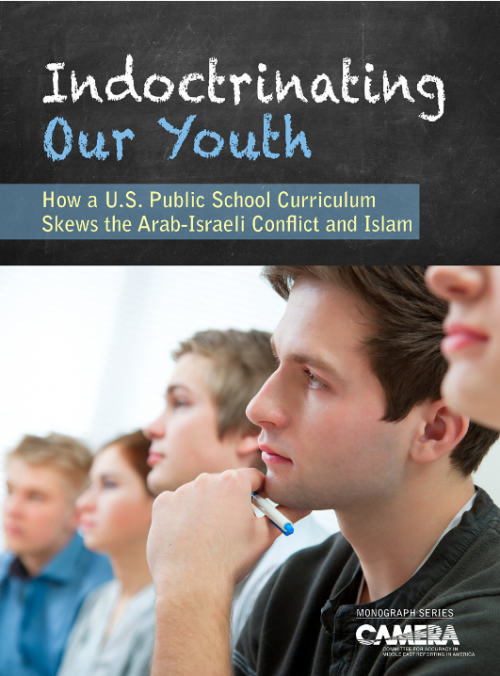
Below, I review this new CAMERA monograph and highlight the important contributions it makes. A statement from CAMERA’s Executive Director and the study’s author exclusive for LI appears at the end of the post. [Note: all images in this post are from Indoctrinating Our Youth and are reproduced here with permission; page numbers in the post refer to those in the monograph].
The post is organized as follows:
- Overview of CAMERA’s New Study
- Backstory of the Newton, MA Curriculum Controversy
- The Battle and the School District’s Defense
- The Current Status of the High School History Curriculum in Newton, MA
- Curriculum Analysis: Arab-Israeli Conflict
- Curriculum Analysis: Islam
- Unique Aspects of the Newton, MA Curriculum Conflict
- A Central Lesson for Other U.S. Public School Systems
- Statement from CAMERA Exclusive for LI
- Conclusion
Overview of CAMERA’s New Study
Founded in 1982 as a non-profit 501 (c)(3), CAMERA is a national media-monitoring organization that works to promote more accurate, balanced and complete coverage of Israel and the Middle East. It’s a watchdog group that exposes instances of bias and skewed reporting in the mainstream media in the U.S. and abroad.
Occasionally it also publishes monographs that offer more in-depth analysis of trends in the representation of Israel and the Middle East in the media, on the American campus, in U.S. mainline churches, and in other arenas.
Indoctrinating Our Youth is its latest monograph in this series.
Basically the report is a “scholarly and frightening account” of how an astonishingly large amount of “inaccurate and partisan materials” made their way into the Newton Public School curricula.
As CAMERA researcher and author Steven Stotsky describes it (p. 8):
This monograph presents a case study of a nationally prominent public school system whose curriculum was compromised by inaccurate accounts of the Israeli-Palestinian conflict and simplistic expositions of Islamic culture. As school systems continue to introduce contemporary politically contentious topics into their curricula, there are valid concerns that students may be exposed to indoctrination rather than factual, objective accounts.”
Divided into an introduction and 5 parts, it includes 15 attachments and an impressive total of 271 footnotes containing citations to literally hundreds of sources—scholarly books, journal articles, school committee meetings, media coverage of the case and more.
The book begins by tracing the origins of the Newton curriculum controversy. It recounts key events based on numerous interviews that Stotsky conducted over the last two years (pp. 10-24 and Attachments 4-10).
Several chapters are also devoted to a meticulous analysis of the problematic course materials, including textbook chapters, handouts from online sources, in-class group exercises and other assignments, and videos screened during the classes (pp. 25-57 and Attachments 1-3, 11-15).
Specifically, the study focuses on the Newton 10th grade World History course unit on the Israeli-Palestinian conflict and the 9th grade World History course unit about Islamic history and culture. An additional analysis of an elective course on Terrorism is also included (p. 50).
In a careful analysis of all these teaching materials, Stotsky shows that many of the textbooks written by supposed experts were “riddled with factual errors”, and omitted key historical and contextual information, or “glossed over” controversial topics.
But as Stotsky highlights, the problem isn’t just with anti-Israel textbooks or simplistic textbook passages about the history of Islam.
Another drawback to the Newton classroom lessons is that so much of the teaching is given over to sources from the Internet with (often sketchy) journalistic reporting and opinion-editorials substituting for historical, factually-accurate scholarship.
Backstory of the Newton, MA Curriculum Controversy
Last April we wrote about the systematic introduction of anti-Israel materials into the high school curriculum in Newton, Anti-Israel Propaganda Reaches Public Schools.
As we noted, the controversy erupted in 2011 when a freshman at Newton South High School became worried over a particular sentence in her history textbook and brought it home for her father to see.
Specifically, the student—Shiri Pagliuso—asked her dad if it’s true that the Israeli government and military torture and murder Palestinian women.
Turns out Pagliuso had ‘learned’ the information from a 540-page Saudi-funded textbook—the Arab World Studies Notebook.
As described in the CAMERA monograph in Attachment 7 (p. 85), it’s a binder of information about Islam and Arab culture that was used in the Newton schools, and in many other public school districts around the country since the 1990s.
Back in 2004, the book was condemned by the American Jewish Committee in a 30-page scathing analysis (pp. 13-14). A number of school authorities withdrew the book on the basis of the AJC report. According to the AJC, the Notebook was full of:
overt bias and unabashed propagandizing, such as depicting Israel as the aggressor in every Arab-Israeli war and praising Muslim conquerors throughout the ages for their ‘gentle treatment of civilian populations’.”
Some sections of the Arab World Studies Notebook inaccurately stated that Palestinians could trace their ancestry to the Canaanites; that Jerusalem was an “Arab City” usurped by Israel; and that “Islam’s religious ties to the holy city are equally long and much deeper” than either Judaism’s or Christianity’s. The book also suggests that a “Hollywood Jewish conspiracy” exists to promote a “negative image of Arabs in cinema” (pp. 13-14).
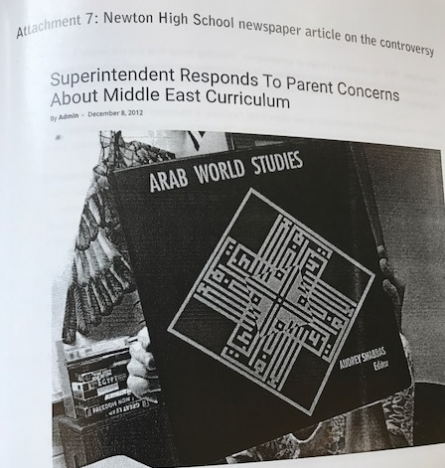
The particular sentences that bothered Newton’s Shiri Pagliuso and her father were:
Over the past four decades, women have been active in the Palestinian resistance movement. Several hundred have been imprisoned, tortured, and killed by Israeli occupation forces.”
Correctly viewing the passage as “outright propaganda”, Pagliuso voiced his concerns to the history teacher who assigned the material, to the History Department Head, and to the school principal (p. 16).
What ensued was a bitter battle that for some years pitted Pagliuso, soon joined by other concerned Newton residents, against the city’s school officials. The disagreement wasn’t just over the problematic Arab World Studies Notebook but widened out to a whole range of classroom teaching materials related to the teaching of Islamic history and the Israeli-Palestinian conflict (pp. 16-22).
The Battle And the School District’s Defense
At first Newton school officials didn’t even want to remove the offensive Arab World Studies Notebook, defending the text as essential for providing an “Arab point of view” and “sharpening the students’ critical thinking skills” (p. 17).
That is, the position of the school officials was that even though some of the materials that the students were learning from were “inaccurate”, it was nevertheless worth using them (pp. 16-17).
So they didn’t dispute Pagliuso’s allegations about the poor scholarly content of the Arab World Studies Notebook.
Instead, the school district defended teaching the factually-flawed textbook because it’s “important to provide students with a ‘balanced perspective’.” According to Stotsky, this became a phrase that Newton school officials would repeat time and again in various meetings (p. 17).
Pagliuso and other concerned parents and Newton citizens disagreed, countering that high school students lacked sufficient knowledge about the subject matter to be able to clearly distinguish between facts and falsehoods. At various school committee meetings they persisted in questioning the value of assigning error-ridden reading materials to young, impressionable students (pp. 17-18).
As Stotsky recounts, school officials reacted negatively to these comments, expressing concern with parental involvement in the school curricula. Newton School Committee Vice-Chair Matt Hills, minimizing the problem, reportedly also told a local newspaper that “academic freedom was at stake” (p. 18).
In July 2012, Newton School’s Deputy Superintendent reportedly told a group representing the parents that “it is acceptable for students to use materials with factual inaccuracies” in order to help them become better critical thinkers, and that “there is no need to review materials used in controversial or sensitive subjects because ‘we trust our teachers’.” Like Matt Hills, the deputy superintendent reportedly also stated that “neither parents nor anyone else was permitted to view any materials used by students”(pp. 18-19).
So the school district resisted for over a year, eventually relenting. It pulled the Arab World Studies Notebook.
In a 2-page statement released in Fall 2012, the Superintendent of Schools David Fleishman explained that the text was being removed because it was “outdated.” Notably, the statement didn’t take issue at all with the textbook’s many factual errors, virulently anti-Israel or racist antisemitic passages. But Fleishman did use space to praise it’s “primary sources” for being of “value to some faculty” (p. 17; see also Attachment 4, pp. 81-82).
However, despite its official removal from the curriculum, passages from the Arab World Studies Notebook were reportedly still being used in downloadable lesson plans for a Newton South High School 9th grade class in subsequent semesters (Attachment 9, p. 91).

Several years later, a 2014 commissioned review of an additional 26 teaching materials that the ad-hoc group of parents and concerned Newton residents managed to get a hold of up to that point indicated a much wider problem in the teaching units devoted to the Israeli-Palestinian conflict and Islam.
Prepared by Verity Educate, the 153-page report showed that a sound, scholarly curriculum still wasn’t being presented (p. 21). The Executive Director of Verity Educate reportedly tried to discuss the report with Newton school officials on multiple occasions but received no response. According to Stotsky:
As far as is known, the comprehensive Verity Educate report was not reviewed by Newton school faculty or the school committee.”
The Current Status of the High School History Curriculum in Newton, MA
The ad-hoc group of parents and concerned Newton citizens filed a Freedom of Information Act (FOIA) request with the school district in late 2014 in order to gain access to the curriculum materials.
The school system began to comply with the FOIA request in the spring of 2015, providing materials from the 9th grade World History unit on Islam and the 10th grade unit on the Israeli-Palestinian conflict.
As Stotsky notes, by the time he undertook his study of these curriculum materials provided by the district, some of the more egregious materials in use back in 2011(reviewed in the Verity Educate 2014 report) had already been removed.
This includes handouts from the horrible Islamicweb.com which contains “numerous diatribes against Jews, Christians, and non-Sunni Muslims” (pp. 51, 69, fn. 8) and a photocopied page (Attachment 1, p. 70) called “Flashpoints: Country Briefing Israel-Palestine” which was chock full of erroneous information (like identifying Tel Aviv the capital of Israel and Jerusalem as the capital of Palestine).
Stotsky writes:
The importance of continued involvement by parents and community groups cannot be overstated…It seems likely that the publicity stimulated by the controversy has prompted more thoughtful selection of materials and more careful vetting of them than occurred previously. The materials provided in the FOIA requests did not include some of the most biased and academically unsuitable items examined in 2011 through 2014” (pp.67-68).
So Pagliuso and the ad-hoc citizens’ group, along with other community groups, like Americans for Peace and Tolerance (APT) and Parents for Excellence in Newton Schools (PENS), are the heroes of this saga.
If it wasn’t for their dogged pursuit of a quality education for their city’s young adults, the biases inherent in the curriculum most likely would have never come to light and Newton educators would probably still be relying on all of their “compromised sources” (p. 68).
You can watch below the recorded statements of Newton resident and APT President Charles Jacobs and Margot Einstein, founding member of the ad-hoc citizens’ group, at Newton Public School Committee meetings in 2012 and 2013. They give you a good sense of their many efforts on behalf of the students, and the run-around they got from school officials:
The controversy now seems to have died down. But it “remains unresolved.”
Charles Jacobs reportedly believes that anti-Israel material is still being taught to Newton’s students.
Stotsky thinks it’s really impossible to know because school authorities refuse to identify what Israel-related materials are being used by teachers (they won’t post curriculum materials on their websites as many other schools and school districts around the country do).
In an interview last week, Jacobs noted that APT was committed to “building support for a policy of transparency” for Newton’s Public Schools.
Curriculum Analysis: Arab-Israeli Conflict
Stotsky’s coverage of the 2011-2015 classroom materials about the Israeli-Palestinian conflict takes up 16 pages of his book (pp. 25-40).
In them, he undertakes a detailed analysis of a host of diverse items presented to the students:
- videos explaining the conflict taken from Internet websites;
- maps from Palestinian sources;
- timelines for the conflict;
- opinion editorials from various newspapers;
- lesson plans and in-class exercises; and
- chapters from textbooks.
As Stotsky shows, the bulk of the materials work to make Israel look bad.
One of the videos (a 5-part 35 minute NYT production), for example, fails to “mention the key fact that Israel has made numerous, far-reaching offers of peace that entailed creation of a Palestinian state” (p. 28).
The Palestinians’ repeated refusal of these offers is essential information for students, but such facts preventing peace are omitted.
Several of the textbooks utilized in the course also depict Israel as unwilling to compromise—while exonerating the Arabs.
For example, World History: The Human Odyssey published by the National Textbook Company in 1999 incorrectly claims that after the 1967 war Israel refused Arab entreaties to return the territories it had seized in exchange for peace (p. 35).
The reality is exactly the opposite: in the immediate aftermath of the war, it was Israel that offered to turn over the captured territories but the Arab states, meeting in Sudan in August 1967, issued what’s known as the “three ‘no’s”—no to recognition, no to negotiations, and no to peace.
Newton students were given a false PLO-produced anti-Israel propaganda map which provides erroneous information to teach about Israel’s “theft” of “Palestinian land” (another map that Stotsky flags also claimed that Palestinian cities are “walled in” by Israel).
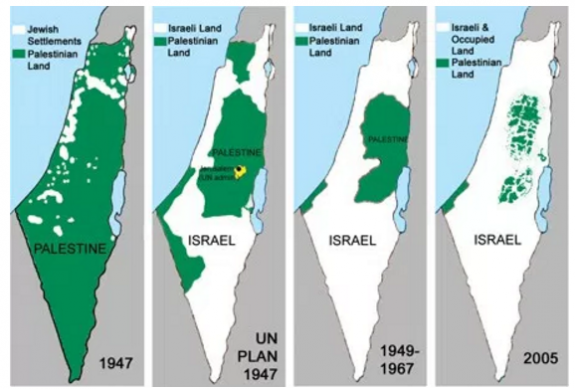
But just as bad as the material that’s presented is everything that isn’t.
For example, in a textbook chapter covering the origins of the conflict (The Modern Middle East published by Oxford University Press in 2011) author James Gelvin depicts the Jews as “colonialists” who opposed the “indigenous Palestinian inhabitants.” Notably sidelined from his analysis or timeline though is any mention of Haj Amin al-Husseini, the Mufti of Jerusalem who disseminated wild myths that Jews were a threat to Muslim holy sites, helping to instigate repeated bloody massacres against defenseless Jews.
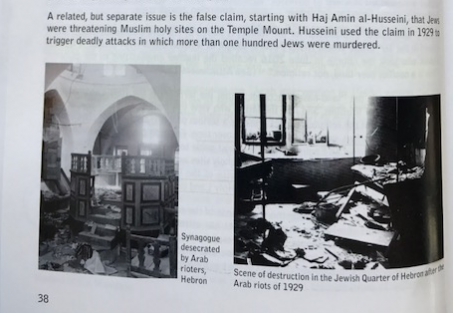
Nor does the chapter note that Husseini was a devoted “admirer of European fascism” who spent the WWII years in Berlin helping to recruit Bosnian Muslims for the SS and to produce pro-Nazi propaganda (pp. 36-37).
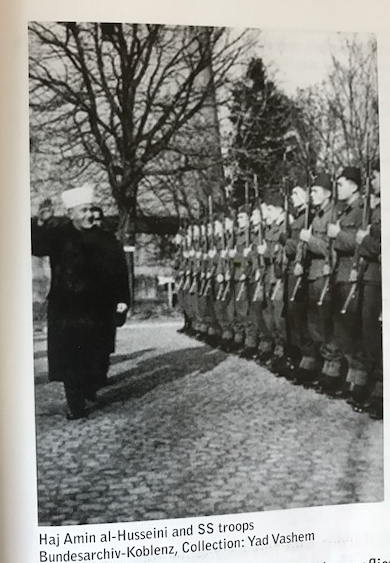
As Stotsky argues, all of this is important information for students because Husseini wasn’t a “fringe zealot” but an influential political and religious figure who trafficked in antisemitism, rejected Jewish-Arab coexistence, set the direction for the Palestinian national movement, and has had a lasting impact on Palestinian culture.
If you’re trying to teach why peace and the two-state solution has proven so elusive, that’s good information to give students.
Especially appalling in terms of omissions was an 8-page “Point of View” outdated timeline of the conflict produced by American Documentary, Inc. in 2001 (pp. 29-31). Stotsky notes that it was written by Negar Katirai, a Council on Foreign Relations intern who credits Mark LeVine, a professor at the University of California, Irvine and a staunch advocate of the anti-Israel BDS movement, with helping her develop it (Levine once wrote in 2009 that Israelis have an “addiction to violence” and suffer from “collective mental illness”).
The Katirai/LeVine timeline omits any mention of the numerous Arab terror attacks inside Israel during the 1970s and 1980s, including the horrific Coastal Road Massacre in 1978 (see our post on this devastating attack).
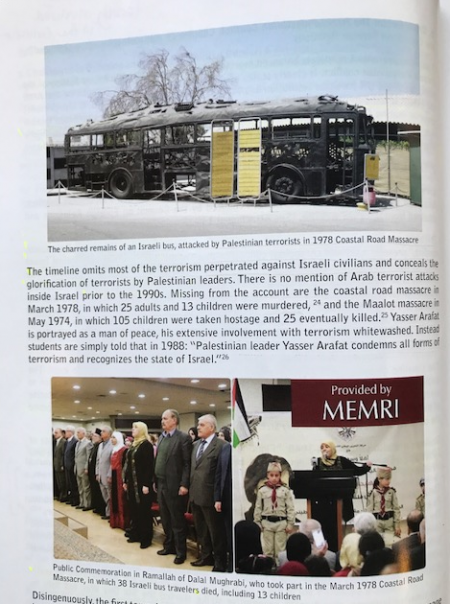
It also has a truncated examination of the origins of the Six Day War which fails to mention Arab leaders’ calls to annihilate Israel, the Egyptian blockade of Israel’s Red Sea passage, or the buildup of its troops in the Sinai (see the LI series on the 1967 war here):

(In another document that Stotsky reviews produced by the Watson Institute at Brown University, it gets even worse. In it, the authors actually blame Israel for the Six-Day War, stating that leaders had “little faith in diplomatic solutions.” There’s no mention in the handout of the Arab provocations that prompted Israel’s preemptive strike in self-defense—p. 32).
The students were given (as handouts downloaded from the Internet) plenty of maps that simplified the complex scenario of Arab flight in 1947-1948 and instead “promoted the narrative of ethnic cleansing” (p. 32-33). But there were no maps in the curriculum showing the forced flight of nearly 1 million Jews from Arab states—the Jewish nakba.
Absent from the many materials that Stotsky reviewed is any discussion of the relentless incitement to violence against Israelis and Jews in official Palestinian media, schools, and mosques (p. 26).
Palestinian terrorism (when it is presented) is depicted as limited to an extreme fringe and unrepresentative of society as a whole, even though public opinion polls in the West Bank and Gaza show widespread support for violence against Israelis. The incessant glorification of terrorists as heroes and righteous martyrs to be emulated, and the naming of schools, public squares, and cultural events in their honor is also missing from the curricular materials (pp. 26-27).
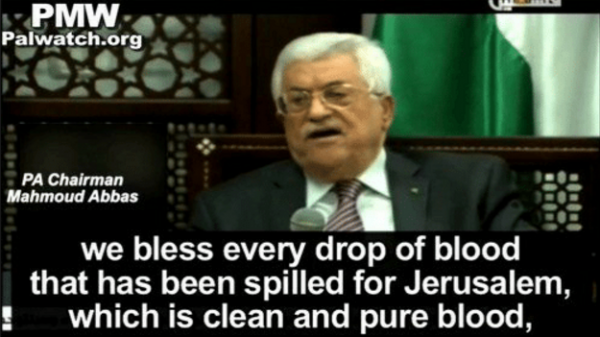
[Palestinian Authority Television | September 16, 2015]
partial view of the conflict, ignoring or downplaying many of the contributing factors. For example, largely concealed from the students are the religious component of the conflict, the persistence and extent of Palestinian terrorism, the oft-stated refusal by Palestinian leaders to accept a Jewish state, as well as the hate-filled rhetoric and incitement against Israel and Jews that saturates Palestinian political discourse. As a result, students are given a distorted view of the conflict and a misleading, benign image of Palestinian national movements. Former leader Yasir Arafat and current leader Mahmoud Abbas are depicted as firmly committed to negotiating peace, when, in fact, many of their statements and actions suggests otherwise (p. 25).”
Of course, not everything was equally dreadful.
Stotsky admits that an interactive video produced by the Council on Foreign Relations presented a “relatively balanced overview” of the conflict (p. 29).
A 2011 opinion-editorial (p. 34) by David Makovsky, a scholar at the Washington Institute for Near East Policy, distributed to students as a handout is also cited as helpful in demonstrating how borders could be adjusted in a final peace deal, even if it didn’t shed any light on the political or religious factors that have stood in the way of achieving this straightforward compromise.
Also in relatively good shape were a teacher’s class notes from 2013 (Attachment 12, pp. 96-98). In them, the teacher exhibits an admirable willingness to explain to her students that “Israel needs defensible borers and defendable territory.” But she also discloses her plan to present the conflict as primarily “over land” and “not inherently a religious conflict” (bold and underline in the original).
This “land-based account” isn’t wrong. But it obscures the fact that for many Palestinians the conflict is a holy war with Jews seen as infidel interlopers on sacred Islamic sites, as the heated anti-Jewish vitriol and violent escalation over Israel’s recent installation of a few metal detectors at the entrance to the Temple Mount makes clear.
This religious component of the conflict has only intensified, rather than diminished, over time. The high schoolers in Newton learned very little, if anything at all, about it.
Curriculum Analysis: Islam
Stotsky devotes 9 pages of his report (pp. 41-49) to reviewing the classroom materials about Islamic history and culture, encompassing some 500 pages released by the school district in response to the 2014 FOIA request.
They include chapters from world history textbooks; selections from introductory textbooks on Islam; handouts from newspaper and magazine articles; a film and a classroom exercise.
To his credit, Stotsky acknowledges the value of the unit in general and in teaching history in a way that gives greater recognition to non-Western contributions and beliefs (pp. 7, 60).
There’s nothing wrong with expanding the knowledge that American youth have about current events in the Middle East or fostering a “multicultural awareness” of the Arab world and Islam, an effort that has bipartisan support.
For example, the Family Foundation of Dick and Betsy DeVos, U.S. Secretary of Education, is a major funder of educational initiatives promoting a social studies curriculum on the Middle East including those that seek to “foster a personal understanding between the American people and the people of the Arab world” (p. 69, fn. 12.)
But as Stotsky mentions and others have noted, problems can arise if an accurate, fact-based teaching of history is sacrificed to make room for a continual questioning of “preconceived prejudices” or a shifting away from the important contributions of America and the West (pp. 10, 68).
This seems to be a big part of what’s gone so very wrong with Newton’s 9th grade World History unit on Islam.
Stotsky documents a “marked tendency to downplay or gloss over negative aspects” of Islamic societal practices. So on the basis of the materials presented to them, Newton high schoolers weren’t given the opportunity to “address contemporary problems with Islamic society in a critical manner.”
For example, he points out that one particular book chapter (Attachment 2, pp. 71-77 from Ira Zepp, A Muslim Primer: Beginner’s Guide to Islam, University of Arkansas Press, 2000) “presents an embellished description of the status of women in Islamic societies” by concealing information about honor killings, genital mutilation, the stoning of women accused of adultery, forced conversions of ‘infidel’ women, or the treatment of women as property in some Islamic countries:
Zepp could have chosen to argue that these practices are cultural artifacts distinct from or are distortions of Islamic teachings. But he chose instead to ignore the topic entirely…” (p. 43).
The controversial concept of jihad was also given “superficial treatment” in the Newton curriculum.
One (unattributed) handout downloaded from an Internet source (p. 45) depicted jihad solely as a “personal-spirited struggle towards discipline” (and not as an obligation to war in the name of Islam). Reputable scholars note that this isn’t a prominent interpretation of the term for most Muslims.
Stotsky also reviews a number of texts and class assignments that portray Muslim conquerors as “tolerant toward their conquered subjects” without offering any solid factual evidence to back up such a sweeping and questionable assessment (p. 46-48).
The inferior status and often precarious situation of non-Muslims under Islamic rule isn’t discussed at all.
One textbook (Early Islam) even preposterously asserts that Muslim rulers were “especially liberal with the Jews and Christians”—as if they had equal rights and opportunities, free from discrimination.
Bigotry against Muslims in the United States is a central topic covered in the unit, but Stotsky’s review of this material isn’t very encouraging either:
Students are presented with a negative image of an America infected by rampant Islamophobia” (p. 48).
One source provided to students—a sloppy and under-sourced 5-page opinion editorial from Time Magazine published in 2010—incorrectly states that “Jews, Mormons and others still experience hate speech. But the most toxic bile is reserved for Muslims” (p. 49).
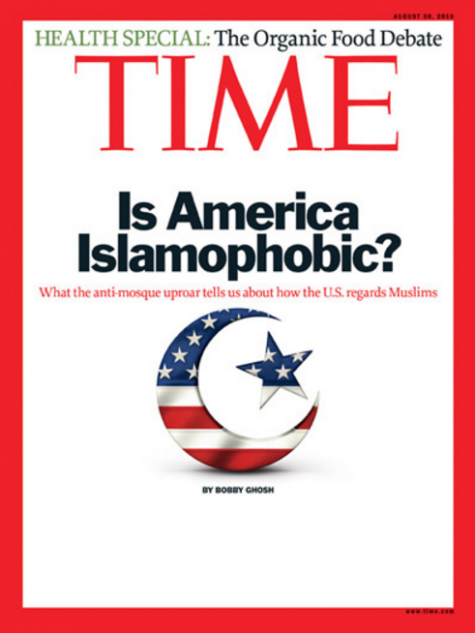
The reality, according to FBI statistics, is that Jews remain by far the most frequent targets of religiously-motivated hate crimes in America.
It’s all very disturbing, in terms of an unwillingness to delve into the topics of Islamic radicalism, or the ways in which extremists use Islamic doctrine to promote totalitarian and misogynistic ideologies that have managed to attract a substantial following.
But one of the most unfortunate aspects of the unit is the absence of many renowned, authoritative voices. It’s a shame that Newton students weren’t offered the chance to learn from the preeminent scholars of Islamic history, such as Bernard Louis or the late Fouad Ajami and others (p. 51).

[Bernard Lewis]
Unique Aspects of the Newton, MA Curriculum Conflict
Indoctrinating Our Youth documents the great lengths taken by the administrators of one U.S. public school system to thwart the efforts of an ad-hoc group of parents and concerned citizens, and several other organizations (notably APT and PENS), who raised legitimate concerns about a high school history curriculum.
But much of what happened in the Newton may be quite particular to that place—a perfect storm combining difficult school administrators, a rather flaccid response by the local mainstream Jewish establishment, and an unhelpful elected school body.
As detailed via media accounts and Stotsky’s many interviews with those involved, it’s clear that public school officials in Newton fought the parents tooth and nail and tried to derail their efforts every step of the way.
The degree of condescension and hostility exhibited by school officials toward the parents is shocking.
In Massachusetts any citizen—and not just parents—are entitled by state statutes to view all materials that teachers use with students. Yet school officials dug in their heels and repeatedly refused to comply with the law (pp. 18-19). The protesting parents had to eventually file a Freedom of Information Act (FOIA) request in order to force the school to release some of the materials (pp. 21-22).
One document included in the report (Attachment 5, p. 83) that I found especially obnoxious was the principal of Newton South High School’s insistence that the parents pay $3,643.10 to cover clerical and photocopying expenses before they could have access to the materials. You can’t get much more petty than that:
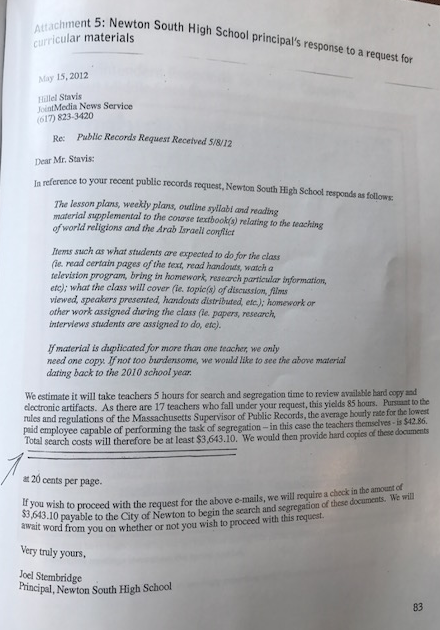
It’s a bewildering level of obstruction that can only be idiosyncratic to the Newton Public Schools.
Also particular to Newton is the elected school committee’s apparent unwillingness to work with the parents and other concerned Newton citizens. As described by Stotsky, the committee (which is charged with supporting parents in their engagement with school officials) exhibited a marked degree of hostility toward them:
The Newton school controversy escalated after members of the elected school committee sided with the school administrators, leaving a group of concerned citizens without representation…By siding with the superintendent, the school committee relieved their most senior employee of the responsibility of providing a substantive response to valid complaints about the materials” (p. 66).
There’s also some indication that the local Jewish organizations in Newton—including the JCRC and, at least initially, the local chapter of the Anti-Defamation League (see pp. 19-20 and Attachment 8, p. 90)—were less helpful to the parents than they might otherwise have been. This too is odd, and seems to me to be particular to Newton.
Bottom line: whether this sort of egregious disregard for parental concerns would repeat elsewhere is questionable. The reality is that there are some recent examples of school administrators and the mainstream Jewish community working swiftly with parents to address their concerns about problematic materials used in K-12 curricula.
A Central Lesson for Other U.S. Public School Systems
What happened in Newton was particularly appalling.
Even so, a lot of what went on there is repeating in other places. That is, even though an astonishing number of impediments there exacerbated the controversy made it difficult to remove the problematic material in a timely manner, the Newton case isn’t an outlier. A better understanding of what occurred there will help to raise awareness of trends underway.
Like in Newton, we’ve documented a similar experience with school administrators in Ithaca, NY, where a FOIA request also had to be filed in order to gain access to problematic school materials.
Virulently anti-Israel professors abusing university K-12 outreach programs to push biased materials into their local public schools also isn’t unique to the Newton case.
In Newton, the nearby Harvard University Middle East Outreach Center, directed for some years by the virulently anti-Israel Paul Beran (pp. 12-14, 61), disseminated biased materials to high school teachers, assisted them with their lesson plans, and ran political-advocacy workshops (pp. 12-14).
A short documentary that exposed the activities of the university’s Outreach Center and its outsized influence on Newton educators was produced in April 2016 by Americans for Peace and Tolerance:
As the film shows, the connection between the federally-funded Harvard University center and the Newton Public Schools was particularly harmful to the history curriculum there, given Beran’s anti-Israel agenda.
But these gown-to-town collaborations are happening in many other American university and college towns, in some cases with the same negative outcomes for public school curricula.
It’s not hard to see why.
As Stotsky notes, K-12 outreach is a necessary component of Title VI federal grants. Because of that, symbiotic relationships tend to develop between the Middle Eastern Studies centers and programs on university and college campuses and the local public schools—as occurred in Newton.
By “promoting or giving away” (p. 68) teaching materials, the Centers get their Title VI grants approved because they can tick off the K-12 outreach box. Meanwhile, the school districts get free educational materials and lectures from distinguished university professors who are “some of the most recognizable names in academia” (p. 69).
So one of Indoctrinating Our Youth’s most important lessons is obvious: in considering material to use for curriculum units devoted to the Israeli-Palestinian conflict and Islam, school districts should carefully vet how these subjects are being presented in the materials freely offered to them by local university Middle Eastern Studies Outreach Centers.
This is crucial because, as Stotsky points out, many of these Title VI Centers for Middle Eastern and Islamic Studies have also been generously funded for years by multi-million dollar gifts from Saudi Arabia and Gulf Arab states and are top-heavy with faculty who are at the forefront of the anti-Israel BDS movement and favor anti-Western Islamic perspectives (pp. 60-62).
Bottom line: one of the key problems in Newton was how biased viewpoints from vehemently anti-Israel and pro-BDS faculty at Harvard seeped into the high school teaching curricula through the workshops conducted and course materials distributed by a university-affiliated K-12 program. So all communities should review the associations that their public school districts have with these university Outreach Centers.
Statement from CAMERA Exclusive for LI
I reached out to CAMERA’s Executive Director Andrea Levin and Indoctrinating Our Youth author Steven Stotsky for comment.
Specifically, I asked them to address: What lessons for other school districts emerge from the Newton case study? What should communities, concerned citizens, and Jewish organizations be doing differently or better to address the problems flagged in the book?
Levin and Stotsky replied with a joint statement:
1) Most important is that parents and concerned citizens realize that change has been occurring in many schools. There’s been a drift away from traditional teaching of history, including avoiding politics in the classroom. Material from the Internet is also too often used without its being vetted for accuracy and academic merit. And, unfortunately, we can’t assume that school officials and the school committee are keeping a careful watch on all this. This means more community members have to become active in reviewing what’s being taught.
2) Community members have a legal right to examine materials used to educate children in the public schools and citizens need to insist on transparency even if it means resorting to the legal system. School officials and school committee members need at times to be made aware that the public has this right to know what’s being taught.
3) Citizens should insist that school officials and school committees and boards put in place permanent procedures to review materials used to teach history. This is especially necessary if the course is going to include controversial or contemporary issues, such as the Arab-Israeli conflict, and to rely on Internet content.
4) It’s often best to join with others in the community who share the concern about protecting standards and avoiding politicizing the classroom.
5) It’s important if there are clear problems of bias in a school to document the issues carefully and factually and to approach officials with detailed information.
It’s a helpful to-do list.
Conclusion
Six years ago a discerning 9th grader in a leafy, heavily Jewish Boston suburb showed her father an inflammatory passage about Israel written in her history textbook.
The discovery led to the revelation of a high school curriculum rife with “politically charged” materials, serious factual errors, and even blatant antisemitic tropes.
CAMERA’s in-depth study of these teaching materials and the controversy that erupted over them in Newton, Massachusetts in 2011 reveals:
- a teaching staff unable to properly evaluate the noticeable biases contained in materials downloaded from the Internet and in materials provided to them by anti-Israel, BDS-affiliated university faculty; and
- a school district astonishingly unresponsive to the legitimate concerns of parents and other city residents.
In some ways, and especially in terms of the outrageous degree of hostility exhibited toward the parents and ad-hoc group of concerned Newton residents, what happened there is probably unique.
Still, CAMERA’s case study of Newton’s “agenda-driven history curriculum” isn’t a one-off.
There are dozens of other cases of virulently anti-Israel teaching materials being used in U.S. public school curriculums. In the rest of the country too, America’s youth are being taught from a set of highly simplistic and “misleadingly rosy” curricular materials about Islamic history and culture. Examples have surfaced across the country in recent years, including in school districts in Georgia, Tennessee, Washington, Arizona, and Texas.
CAMERA’s latest monograph provides a deep-dive into another disturbing instance of this “rotten educational malpractice”. Basically, the report shows how for years high schoolers in Newton, MA have been taught a tale of Jewish-inflicted misery.
It’s hard to know for sure, but it’s probably safe to say that the kids there are still learning this ‘lesson’ today.
Miriam F. Elman is an Associate Professor of Political Science and the Robert D. McClure Professor of Teaching Excellence at the Maxwell School of Citizenship & Public Affairs, Syracuse University. She is the editor of five books and the author of over 60 journal articles, book chapters, and government reports on topics related to international and national security, religion and politics, and the Israeli-Palestinian conflict. She also frequently speaks and writes on the Boycott, Divestment, and Sanctions (BDS) anti-Israel movement. Follow her on Twitter @MiriamElman
 DONATE
DONATE
Donations tax deductible
to the full extent allowed by law.








Comments
Ahh, time to get a new school board and fire the school Administrators.
Past time
“Then enemy of my enemy is my friend.”
Of course leftist teachers are indoctrinating American children to hate free, American ally Israel and love the fascist, tyrannical and murderous ‘Palestinians’ (or whoever they really are – kind of like ‘barack hussein obamma’))
The crying boehners GOPe did nothing about this while they had every chance to do so. But,there’s a new sheriff on the block. His name is Donald Trump.
Three and a half more years of The Donald to go.
Funny, but American leftist teachers are literally teaching students how to destroy themselves.
ISIS doesn’t need bombs. It just needs to support leftist teachers and the leftist politicians that see they are hired, and the leftist media that elects the leftist politicians.
But a funny thing happened: The attacks of 9/11 were the dumbest things islamic terrorists could have done, because it awoke a sleeping giant. Had they left us alone, by now, America would have quietly rotted from within so severely that the likes of obama would have been elected earlier, and eventually hillary clinton would be president: America would have quietly collapsed into the hands of the American left and their ally, islamic fascists or civil war.
Then again, hillary clinton is such a loser, she’d probably have blown that fixed election, too.
The fecklessness of the GOPe gave us the disaster of obama, which BARELY, gave us, thankfully, the election of Donald Trump.
We now have a glimmer of hope. No one is working harder to block that ray of light more than the rats of the GOPe.
Government bureaucratic schools think your children belong to them. Parents who give them their children seem to agree.
If you change the school board and fire the school administrators, it will still be a government bureaucratic school.
Read “Politics, Markets, and America’s Schools” by Chubb and Moe.
https://www.amazon.com/Politics-Markets-Americas-Schools-Paperback/dp/B014IBIFE4
Abolish the Department of Education, nothing short of this means anything!
The DoEd has nothing to do with this. This is a purely local problem, and would have happened exactly the same had there been not only no DoEd but also no federal involvement in education at all. The real problem is that it’s happening in hundreds of other schools, and in each one it’s driven not by some national conspiracy that can be broken up, but by genuine local antisemites.
i had family in France.
After the Charlie Habdo and other I-Slamic incidents where
Jews who wear Kippahs were attacked – I urged them to make Aliyah.
Is it time for Jews in America also do this ?
(JINOs need not reply).